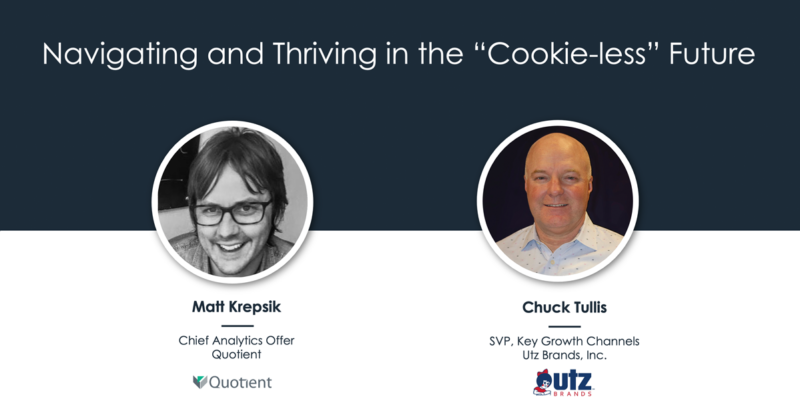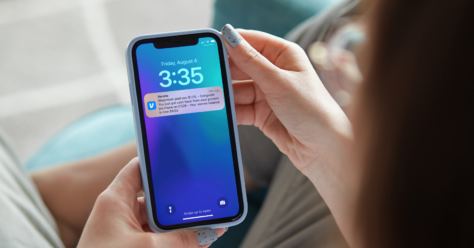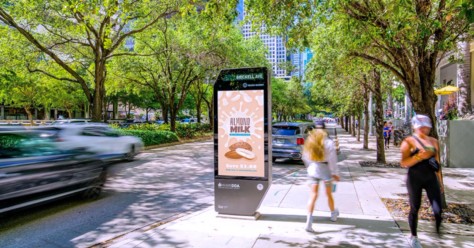Utz Brands + Quotient: Navigating the “Cookie-Less Future”
As consumer privacy concerns become more prevalent, news around the “demise” of third-party cookies has dominated headlines. Apple has helped to lead the charge by blocking the use of third-party cookies on their devices and search engines, and Google isn’t far behind. And yet, many of us are still unclear on how third-party cookies work and what marketers are going to do next.
SVP of Key Growth Channels at Utz Brands, Chuck Tullis, and Quotient’s Chief Analytics Officer, Matt Krepsik, joined forces during their webinar, “Navigating and Thriving in the ‘Cookie-Less Future,’” to break down third-party cookies: what they are, why they’re going away and where the industry is headed next.
Read on or watch the video recording below for a full review of the industry, the changes and the opportunities going forward:
A Cookie Breakdown
Initially, third-party cookies were used simply to track consumers’ previous behavior on a single webpage. Over time, these same cookies evolved to track consumer behavior from one webpage to the next—creating a persistent trail that followed individuals across the internet and developed different affinity and behavioral information about that user.
First-party cookies, on the other hand, tend to operate at the site level. Think about when you log onto a site and authenticate it to remember your username and password. This creates a more convenient user experience that focuses on authenticated, permission-based marketing—also called opt-in marketing. According to Krepsik, these first-party cookies and authenticated, one-to-one user experiences are the future of marketing.
“We’re moving from a world where we’re cookie-based to a world where we’re going to focus more on persistent identifiers. You’ll see the adtech industry start to focus on the value of first-party relationships with our consumers. In many ways, it’s actually a good thing. It gives us greater clarity and provides greater focus around real people and real consumers.”

Where the Industry Is Going
In recent months, you may have noticed apps and various webpages asking you to enable tracking. By enabling these permissions, users are moving into the next phase of marketing that Krepsik described. They’re opting in and allowing apps to track them from one application experience to the next. Increasingly, we’re also seeing a rise in native experiences that are limited to a single app.
“At our core in the advertising world, we want to talk to our consumers as individual people and shoppers.”
Krepsik calls this new phase internet 3.0. If internet 1.0 focused on access to information (for example, the rise of search engines) and today’s internet, internet 2.0, is focused on forming groups and communities (think: social media), then the internet 3.0 of the future is evolving to an individual focus in which users are learning to curate and personalize their experiences online. It is these one-to-one relationships that brands are forming with consumers that both Krepsik and Tullis find most interesting.
“Content is now telling these richer stories, and user experiences are evolving. Brands are starting to have more direct relationships with their customers. It’s about all of us having personal choice and preference and allowing us to engage with the brands we love directly.”
How This Impacts Brands
When thinking about the impact on brands, Tullis believes that it depends on where they are in the journey of building their own database. For his own work at Utz, Tullis’ focus has been on building their database up through mechanisms like a direct-to-consumer site, text messaging campaigns and convincing consumers to opt in.
To keep up with the ever-changing world of digital, Tullis focuses on constantly innovating and learning through small tests that inform his broader brand strategy. In the interest of building up his consumer database, Tullis also looks for new ways to capture consumer data by convincing them to opt in with a fair value exchange.
Take promotions, for example. Rather that executing an instantly redeemable in-store promotion, Tullis recommends using a QR code or digital coupon that drives users to a microsite. This allows brands to get the same in-store execution, but it’s through a digital process that allows them to capture valuable consumer data.
“An FSI doesn’t do anything for you. Whereas when you do this one-to-one, not only do you get better ROI and engagement, you can keep your retails up because you’re engaging with a true enthusiast of the brand and they’re willing to pay the premium.”
AdTech is Changing for the Better
Ultimately, while the so-called cookie apocalypse might make for a catchy headline, both Krepsik and Tullis agree that this is just a natural evolution for the industry. And this change towards more direct, personalized, one-to-one relationships with consumers is a positive one.
To learn how Quotient can help you plan for the cookie-less future of tomorrow, contact our team at communications@quotient.com.



